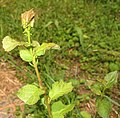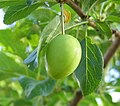Zibarte
| Zibarte | ||||||||||||
|---|---|---|---|---|---|---|---|---|---|---|---|---|
| Systematics | ||||||||||||
|
||||||||||||
| Scientific name | ||||||||||||
| Prunus domestica subsp. prisca | ||||||||||||
| Bertsch ex HLWerneck |
The Zibarte (also Ziparte and Zippate , Alemannic Zibärtle , Zibertle , Zibertl , Ziberl , Zwiferl and Seiberl as well as Swiss German Ziberli , Zyberli , Zibäteli or Zibelle ) is a subspecies of the plum ( Prunus domestica ). Whether it is more like the Prunus domestica subsp. prisca or the form of Prunus domestica subsp. insititia is disputed. The common name today vulgar creep of Prunus domestica subsp. insititia was first mentioned in writing by Hildegard von Bingen . The kernels of fruits of both shapes and sizes were found in Neolithic settlements.
description
The Zibarte is a small tree that usually reaches heights of 3 to 4 meters. Its branches are rather juvenile with thorns and green at the beginning. The leaves are bare, only hairs are present on the underside along the leaf veins . The leaves are rather small compared to other plums, as are the flowers.
The five petals are pure white.
The fruit has a diameter of 2 to 3 (rarely from 1) centimeters. It is spherical and blue, black, blue-red, green-yellow or yellow in color, with reddish cheeks. The stone core is round-egg-shaped and wrinkled, its thickness corresponds to 73 to 79% of the length. The ridge furrow only shows inclined ridge lines in Eastern Alpine varieties. When ripe or overripe, the core only occasionally separates from the pulp.
Cultivation and processing of the fruits
Flowering occurs early in the year, the Zibarte is self-fertile and productive. The fruits ripen from September to October. The flesh is soft and contains a lot of tannin, the taste is more reminiscent of sloes than plums. The average sugar content of the fruits is 15.8% (60 to 70 degrees Oechsle ).
The Zibarten are used, among other things, in the fruit distillery. The Zibartenbrand, called Zibärtle in the Black Forest , is a specialty that is expensive compared to other fruit brandies. This is because the Zibarte is seldom grown and the yield from the fruits is quite low. The brandy compensates for this with an excellent taste and a fine almond tone. In Entlebuch , people know the Swiss-German Zyberlisturm , a sweet dessert specialty.
The plant is less prone to disease. It can serve as a base for other types of plum. In southern Germany, Austria and Switzerland in particular , it still occurs sporadically in true-to-root areas in orchards .
literature
- Walter Hartmann (Ed.): Color Atlas of Old Fruit Types. Ulmer, 2nd edition, Stuttgart 2003, ISBN 3-8001-4394-1 , p. 293 (section cultivation).
- Peter Hanelt & IPK (ed.): Mansfeld's Encyclopedia of Agricultural and Horticultural Crops ( online ; section “Cultivation”).
- ziper, ziparte , f . In: Jacob Grimm , Wilhelm Grimm (Hrsg.): German dictionary . tape 31 : Z-Zmasche - (XV). S. Hirzel, Leipzig 1956, Sp. 1542 ( woerterbuchnetz.de ).
Web links
Individual evidence
- ↑ Peter Schlottmann: Determination of important clans of the genus Prunus, section Prunus - with special consideration of the primitive plums . In: Kiel notes on botany . 39 (2013), p. 59.
- ↑ Hildegard von Bingen: Physica: liber subtilitatum diversarum naturarum creaturarum . Critical text edition, edited by Reiner Hildebrandt. Berlin: de Gruyter 2010, pp. 195 and 268.
- ↑ Heinrich L. Werneck: The root and kernel-correct stem forms of the plums in Upper Austria. In: Natural History Yearbook of the City of Linz. Volume 7, 1961, p. 13 ( PDF on ZOBODAT ).
- ↑ Peter Schlottmann: Determination of important clans of the genus Prunus, section Prunus - with special consideration of the primitive plums . In: Kiel notes on botany . 39 (2013), p. 57.
- ↑ a b c Hildemar Scholz, Ilse Scholz: Prunus . In: Hans. J. Conert et al. a. (Ed.): Gustav Hegi. Illustrated flora of Central Europe. Volume 4 Part 2B: Spermatophyta: Angiospermae: Dicotyledones 2 (3). Rosaceae 2 . Blackwell 1995, ISBN 3-8263-2533-8 .
- ↑ description of Zibartenbrands in a burner .
- ↑ Page no longer available , search in web archives: Description of the Zibarten brandy at a larger distillery .
- ^ Stephan Künzi: Bergmannli, Talherren and the Zyberli. In: Berner Zeitung Online. June 4, 2010, accessed April 25, 2020 .









